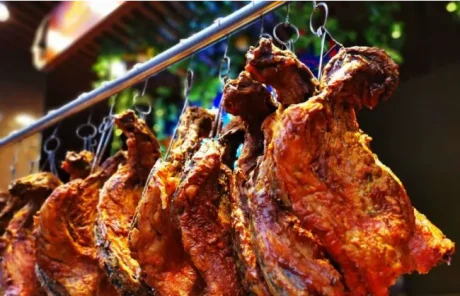Kashgar Travel Guide
Located in the Tarim Basin region of southern Xinjiang, Kashgar is one of the westernmost cities of China which borders Kyrgyzstan and Tajikistan in Central Asia. Thanks to its strategic location, Kashgar has been an important junction on the ancient Silk Road for centuries, having been endowed with a splendid history and diverse cultural influences.
The region is embraced by the Tianshan Mountains, Pamir Mountains, and Taklamakan Desert, with the Kashgar River flowing through the city. Today, there are over 782,000 people here, and most of them are Uyghurs who practice Islam, build their houses in Central Asia architectural style, and still retain the region’s cultural heritage to this day. Their traditional handicraft, bazaars, mosques, and neighborhoods all together contribute to the unique character of Kashgar.
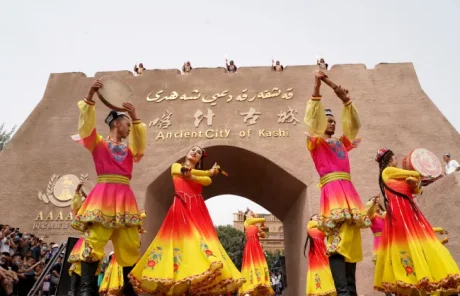
Chinese: 喀什 kā shí
Location: Southwest Xinjiang
Population (urban area): 7,113,000
Why visit Kashgar?
- Explore well-preserved historical and cultural heritages that have witnessed a history of thousands of years.
- Experience the exotic culture and customs in this region. Its Uyghur majority and culture exchange in the past centuries leave Kashgar a charming destination with unique life and tradition.
- Visit the lively and colorful bazaars filled with a variety of goods, from spices, carpets, and handicrafts to livestock.
- Savor local food that is influenced by Middle Eastern, Central Asian, and Chinese flavors.
- Interact with local ethnic groups and experience their hospitality and friendliness.
Traveling in Kashgar means touch ancient Silk Road history and diverse cultures and living traditions. From the maze-like old town streets, stunning blue-domed mosque, century-old tea house to bustling bazaars and craft shops, each corner here tells a story. The city is more than just a collection of architectural masterpieces, it is where thriving cultures set against the breathtaking landscapes of the Pamir Plateau and its pristine alpine lakes.
Century-Old Tea House
Once appeared in the opening scene of the Kite Runner film. More than a tourist spot, it is a beloved gathering place for locals to sip tea, chat, sing, and dance. Feel free to join them during your visit.
Abakh Hoja Tomb
The tomb is the burial site of the leader of the White Mountain sect of Islam and his family. Exemplifying Central Asian Islamic architectural style, its main mausoleum features a 26-meter-high dome clad in green glazed tiles, with walls adorned with intricate blue and white geometric ceramic patterns.
Gaotai Ancient Homes
The Gaotai Ancient Homes, situated on the southeastern cliff of Kashgar Old Town, are a traditional earth-built architectural complex with over 600 years of history. Constructed on rugged terrain, these homes are connected by narrow, winding alleys. It is often called the "living folklore museum of the Uyghur people" for highlighting their unique architectural style and craftsmanship.
Top Things to Do in Kashgar
Visit the Kashgar Old City
A top highlight of Kashgar, the over 2,000-year-old Kashgar Old City is a labyrinth-like neighborhood where narrow alleys are lined with mud-brick houses in Islamic and Uyghur styles. Locals decorate their houses with floral patterns and domes and pave the alleys with bricks of different shapes. The bricks of the alleys serve as direction indicators for visitors, for example, the hexagonal bricks lead to the direction to walk out of the town and quadrilateral bricks show that you are walking to a dead end. A walk through the winding alleys will lead you to the daily life in the ancient town with locals wearing traditional clothes, making handicrafts and instruments in the store, enjoying tea and food in ancient teahouses, etc.
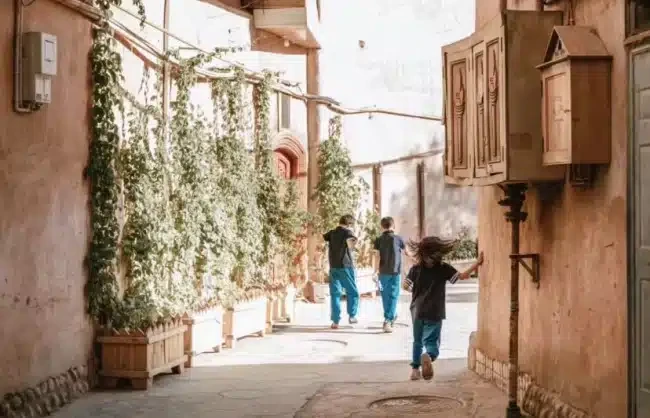
Stroll around Kashgar’s Iconic Grand Bazaar
The Grand Bazaar in Kashgar is the largest and busiest of its kind in Xinjiang. Here you may encounter not only local merchants but also merchants from all over Central and Western Asia. It is a paradise for shopping, and also a place showing the splendid culture and life of local Uyghurs. Taking a leisure stroll around the bazaar, you will surely be mesmerized by the endless stalls selling a variety of products, such as spices, teas, silk, dried fruit, carpets, musical instruments, clothing, and local delicacies.
Experience the Kashgar Livestock Bazaar
A popular animal market, the Kashgar Livestock Bazaar takes place every Sunday from 8 am to 2 pm. Here you will get a rare chance to witness local farmers and traders selling and buying livestock, such as sheep, goats, camels, horses, and donkeys, and find many local cuisines. Boasting a history of over 2,000 years, it is not only a place for goods and animal exchange but also a testament to the region’s rich and diverse cultural and religious tapestry.

Admire the Abakh Hoja Tomb
Abakh Hoja Tomb is a masterpiece of Uyghur architecture that serves as the mausoleum for the Abakh Khoja family. Abakh Khoja was once the leader of this region in the 17th century. The tomb is now one of the holiest Muslim sites for locals, offering a glimpse into the beauty and history of the Uyghur culture and architecture. The tomb chamber is the highlight of the tomb complex, inviting visitors with its big dome of green glazed tiles and the circular edifice with a crescent on top.
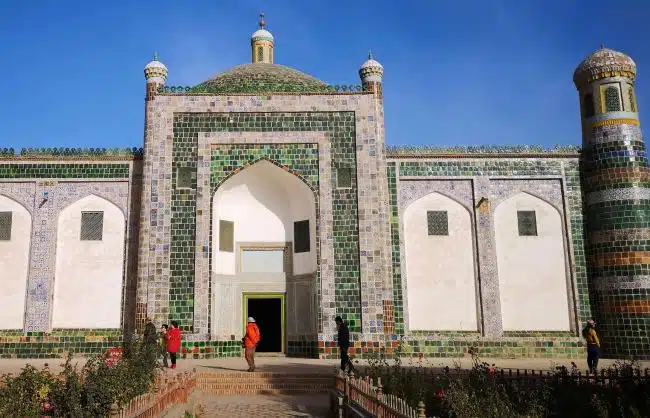
Calm Your Spirit at Id Kah Mosque
Id Kah Mosque is the largest mosque in China, covering an area of about 16,800 square meters, with its lecture hall can house over 20,000 worshippers. The mosque was built by the king of this region in 1442 and now stands as a landmark of local Islamic architecture. It impresses visitors with its yellow brick facade, the green tiles-covered dome, and three towering minarets. To have a close observation, you will be enchanted by the delicate wood carvings, ceramic tiles, and Arabic inscriptions which add the grandeur of the buildings.
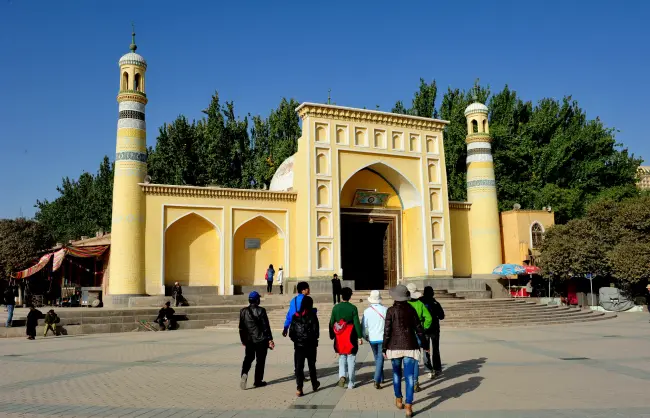
Kashgar Weather & Best Time to Visit
Kashgar has a temperate continental climate with very hot summers and very cold winters. Due to its distance from the ocean, geographical location, and elevation, the region undergoes a dry and low-precipitation climate, with large temperature differences annually and daily. In summer, the highest temperature can reach up to 40℃. January is usually the coldest month with the lowest temperature dropping to -22℃. The best time to visit Kashgar is from May to September when the weather is pleasant and comfortable, suitable for outdoor activities.

Kashgar Accommodations: Where to Stay
Kashgar is not only a popular travel destination but also a main gateway to start your tour in southern Xinjiang. Visitors are recommended to stay at least one night here to explore wonders in its old city and neighboring areas (such as Tashkurgan Stone City, and Karakul Lake).
As the tourism hub of Southern Xinjiang, the city has seen significant improvements in accommodation over recent years. Currently, visitors can find a wide range of accommodation options, from luxury hotels to local-featured guesthouses and budget-friendly hostels.
It is recommended to stay in and around Kashgar Old City for easy access to key attractions, such as the Id Kah Mosque, and the Century-old Teahouse. The old city itself is the essence of the city. To be specific, hotels near the four gate exits of the Old City offer more convenience and comfort. This will avoid the hassle of carrying luggage over cobblestone streets.
Though homestays within the Old City offer more immersive experience of Uyghur life, many of them are converted from old buildings, offering aging facilities. You’d better choose those opened after 2023.
Kashgar Transportation
Kashgar offers multiple transportation options for getting there and getting around the city.
Getting to Kashgar
By air:
You can fly to the Kashi Laining International Airport which is located about 8 km from the city center. The airport operates flights to/from 17 domestic cities outside Xinjiang, such as Beijing, Chengdu, Shanghai, Xi’an, Hangzhou, Guangzhou, etc. and 13 cities inside Xinjiang, such as Urumqi, Shihezi, Kuqa, Yining, Hetian, Korla, etc.
From the airport to Kashgar city center, a taxi ride will cost about CNY 30 and take about 20 minutes. Or you can take a shuttle bus from the airport, which runs every 30 minutes from 8:00 am to 10:00 pm. The shuttle bus ride will cost CNY 10 per person, and take about 30 minutes.
By train:
Currently, no high-speed trains are operating in Kashgar, so to arrive by train, you’ll need to take a normal train and arrive at Kashgar Railway Station which offers daily trains to/off many cities in Xinjiang along the Southern Xinjiang Railway and the Kashgar-Hotan Railway. There are also trains to/off other major domestic cities, such as Urumqi, Xi’an, Chengdu, Turpan, etc.
Getting around Kashgar
Taking a taxi is the most convenient way to travel around Kashgar, and the taxi fares are affordable here. The fare starts at 5 CNY for the first 3 km, and then 1.5 CNY per km after that.
Kashgar has a well-developed bus system, making it convenient to get to most attractions by bus. The bus ride is generally CNY 1 per person.
Walking is also a good choice to explore Kashgar, with many of its attractions within walking distance.
Tips for Traveling in Kashgar
- Respect local culture and customs: Considering the diverse ethnic groups and diverse cultural mix in Kashgar, it’s important to respect local customs. For example, dress modestly when visiting religious sites, and ask for permission when taking photos of people.
- Prepare for temperature variations: There are large temperature differences annually, monthly, and daily, so it’s recommended to layer your clothing and pack accordingly in case of extreme temperature.
- Prepare for language barriers: English is not widely spoken in Kashgar, most locals speak Uighur or Mandarin. It would be helpful to learn a few basic phrases or download a translation app beforehand.
- Drink plenty of water: Kashgar is extremely dry, it’s important to drink plenty of water and pay attention to maintaining body hydration.
- Protect local heritages: Kashgar is rich in historical and cultural heritages, please be mindful of maintaining a clean environment and avoid making damages to the heritages.
- Pay attention to food hygiene: Try diverse Kashgar snacks and specialties is a can’t-miss when traveling in this area. But, it’s necessary to pay attention to food hygiene and choose clean restaurants or stalls for your meals.
Related Reading: Xinjiang Travel FAQs & Practical Tips 2024
